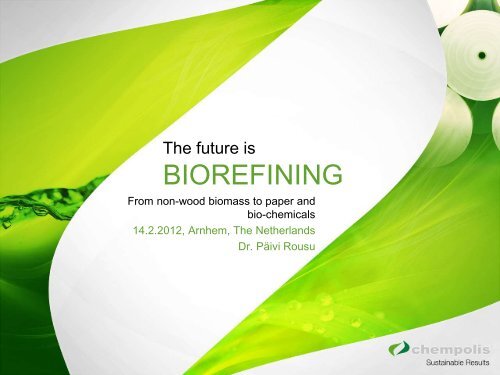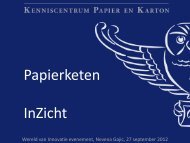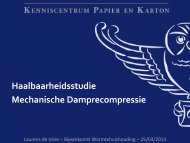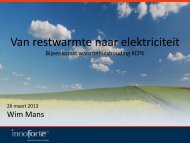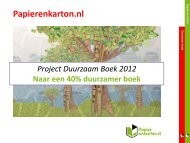BIOREFINING
BIOREFINING
BIOREFINING
- No tags were found...
Create successful ePaper yourself
Turn your PDF publications into a flip-book with our unique Google optimized e-Paper software.
The future is<strong>BIOREFINING</strong>From non-wood biomass to paper andbio-chemicals14.2.2012, Arnhem, The NetherlandsDr. Päivi Rousu
CONTENT• Chempolis Ltd.• Chempolis biorefinery, Oulu, Finland• formico ® 3G biorefining technologies• formicofib TM technology• Products of biorefinery• Economy• Properties of formicofib TM fibers• Use of non-wood fibers• Summary
THE <strong>BIOREFINING</strong> TECHNOLOGYCORPORATION• Biorefinery• Head quarters• R&D Centre• Land area 8,5 ha• Floor area 14 000 m 2Chempolis is private independent medium sized company (est. 1995) whosupplies sustainable globally patented biorefining technologies, which havebeen acknowledged by World Bank, DoE, UPM, BASF and many customers• formicofib the non-wood fibre technology• formicobio the cellulosic ethanol technology
KEY MILESTONES• Established by Rousu family (1995)• Technology demonstration in pilot scale 1995-1997• Entrance to China• First License Agreement in 2000• First Service Agreement in 2003• Evaluations by IFC, DOE, BASF 2006-2007• License Agreement with UPM 2008
KEY MILESTONES AT KEYMARKETS• Establishment ofsubsidiary in China in2009• Expansion to India andSoutheast Asia 2011• 100 th granted patentglobal
CHEMPOLIS BIOREFINERYTOP: NDRC, China, 1.9.2010RIGHT: Minister of New and Renewable Energy, India, 1.4.2011• Overall investment cost ~ 20MEUR• Customer trials and dimensioning of formico ® processes &systems• Continuous operations, industrially proven solutions• Modern DCS (formicocont)
DEMONSTRATION OF formico ®TECHNOLOGIES INBIOREFINERY• Products of our biorefinery:• Pulp for different papers and textiles• Glucose, acetic acid, furfural• Bioethanol and lignin
formico ® technologiesand products
3G FORMICO ®BIOREFINERYNon-Food and Non-Woodbiomass3G formico ®biorefineryPapermaking and textile fibresfrom CelluloseGlucose, bioethanolfrom CelluloseBiochemicalsfrom HemicellulosesSolidbiofuelPower plantPower,SteamFertilizerfrom Ash
3G FORMICO ®BIOREFINERYNon-Food and Non-WoodbiomassSolidbiofuel3G formico ®biorefineryGasificationand synthesisPower,SteamPapermaking and textile fibresfrom CelluloseGlucose, bioethanolfrom CelluloseBiochemicalsfrom HemicellulosesAdhesives and polymersfrom LigninBiodieselFertilizerfrom Ash
formicofib TECHNOLOGYIn a low temperature and pressure,biosolvent selectively dissolves lignin andnutrients of biomass.BiosolventPulp is purified and biosolvent isrecovered by washing with waterWaterPulp is bleached totally withoutchlorine chemicalsWaterNon-woodbiomassformicodeli Washing TCF bleachingPulpSpent liquor isevaporated and dried.Vaporized biosolvent isdirectly recycledfor re-useEvaporationDry biofuelPowerplantformicopureAcetic acidFurfuralWashing liquors and a part ofvaporized biosolvent are distilled intoDry, lignin-rich water and biofuel concentrated is biosolvent.combusted at an on-sitepower plant Acetic that acid generates and furfural, which aresteam and generated electricity during for the delignification andbiorefinery. evaporation, are recovered as valuableco-productsFiltratetreatmentBleaching filtrates are evaporatedand water is recycled for re-use.Thanks to TCF bleaching, there is noaccumulation of chlorine compounds.
formicofib TECHNOLOGYBiosolventWaterWaterNon-woodbiomassformicodeli Washing TCF bleachingPulpEvaporationformicopureFiltratetreatmentDry biofuelAcetic acidFurfuralPowerplantFlowrate, tFlowrate, tBiomass 1000 (dry) Furfural 40Pulp 400 (dry) Solid biofuel 500Acetic acid 30 Reduction ofCO 2800
formicofib TECHNOLOGYWASHING WITH BIOSOLVENTWASHING WITH WATER
PRODUCTS
CO-PRODUCTION OF• Separated in distillationFURFURAL• Chemical feedstock for a number of monomeric compounds andresins• Direct applications: solvent in oil refining, pesticide, flavourcompound• High production costs have limited the use• Potential future application: hydrogenation to 2-MTHF to beused as high-value fuel additiveH +xylose furfural + 3 H 2 O
CO-PRODUCTION OFACETIC ACID• Degradation product from hemicelluloses(acid catalyzed hydrolysis of acetyl groups)• Separated in distillation• Common raw material for chemical industry (vinyl acetate,acetic anhydride, esters, ...)
PROFITABILITY OF formicofibSource: Comparison of Soda, Kraft, Conox, Chempolis and FreeFiber: Investment andProduction Costs, Prefeasibility Calculations. International Finance Corporation (2007)
formicofib NON-WOODPAPERMAKING FIBRES• Selective delignification of biomass to cellulose,hemicellulose, lignin and ash• Products: fibres, acetic acid, furfural, fertilizer andlignin option• Generates 25% more sales value than alkaline non-woodprocesses• Energy self-sufficiency and no need for fossil fuels• No pollution; full recovery of chemicals & water (no silicateproblem)• TCF-bleaching of clean cellulose fibre is easy and nochlorine based chemicals are needed• High quality paper can be manufactured
Properties and use offormicofib TM fibres
POSSIBILITY FOR SPECIALPRODUCTS• Technology has been designed especially for nonwoodfeed stocks• Overcomes the difficulties related to the raw materialcharacteristics• Technological feasibility• E.g. no difficulties in scaling, oxygen chemical based bleaching• 3 rd generation biorefining• Environmentally feasible• Extra income from biomass based on multiple value-added products• Quality of fibers• Dewatering• Runnability
PROPERTIES OF formicofib TMProperty Wheat straw Bagasse Bamboo Corn stalkTensile index, Nm/gUnbleachedBleachedTear index, mNm 2 /gUnbleachedBleachedSR numberUnbleachedBleached55 – 7045 – 552.4 – 3.02.5 – 4.039 – 4527 – 3545 – 5535 – 452.52.0 – 2.53513 – 206030 – 4510 – 138 – 1013 – 1815 – 30Brightness, %Bleached 80 – 85 80 – 89 80 – 87Opacity, %Bleached 77 – 81 68 – 71 70 – 80906.540
PRINTING & WRITING PAPERS• formicofib TM grass pulps are excellent short fibrecomponents and can substitute high-grade euca• Wheat and other straws• Reeds• Bagasse• Long fibre component (>10%)• Bamboo (can also be a major component)• Softwood
PRINTING & WRITING PAPERS• Fines and other fine particles of formicofib TM pulp providepaper• Formation, smoothness, opacity and other printing facilities• High surface and z-directional strength• Adjustable hemicellulose content results• Excellent runnability and wet strength (together with fine structureof fibers)
%PRINTING PAPERS1001.4801.211.41.210.80.60.46040200Opacity Brightness Gloss Printedgloss0.8formicofib reed0.6Wood reference0.40.20formicofib reedWood referenceBulk(calendered),cm 3 /gBending stiffness(calendered),mNmRoughness, PPT(coated),µmformWoo0.20BulkBending stiffness Roughness, PPT
PACKAGING BOARDS –BLEACHED GRADES• formicofib TM straw and reed pulps are excellent fortop layers of cartonboards• Good printing properties• Opacity, brightness and smoothness• Surface strength and z-strength• Suitable density and high tensile stiffness
PACKAGING BOARDS –UN/SEMI-BLEACHED GRADES• formicofib TM reed and bamboo pulps are excellent forfluting• Good strengths combined with high bulk and tensile stiffness• formicofib TM bamboo and reed pulps are excellent forinner layers of cartonboards• Combination of bulk and strength
formicofib TM PULPSPrinting and writing grades• Straws < 80%• Reeds < 80%• Bamboo < 80%• Bagasse < 65%• EFB, OPF < 60%Packaging gradesBleached, surface layers• Straws and reeds < 80%Un-/semibl. fluting, inner layers• Reeds, corn, bamboo < 60%Tissues• formicofib TM non-woods < 60%
PAPER MACHINE TRIALSUSING SINGLE NIP PRESS (METSO)• formicofib TM wheat straw 70 %, rest euca & pine• Speed 900 – 1350 m/min• Filler content 20 – 30 %• Nip pressure 700 – 1300 kN/m• Solid content after wire 19.8 – 23.3 %• Solid content after press 48.7 – 52.4 %• Excellent runnability with different loads of shoe press• Excellent formation and printability
ADVANTAGES OF formicofib- PAPERMAKING“UPM has tested formicofib pulp (70% furnish) successfully on amodern paper machine running up to 1,300 m/min”Source: UPM-Kymmene Corporation, 2009
OTHER USES OF formicofib TM• Dissolving pulp for viscose production• Effluent-free with minimal water use• Chemical modifications for pulp• CMC• Mechanical modifications for pulp
SUMMARY• 3G formico ® biorefining technolgies are the future– High conversion of products give 25-40 % more revenuesthan competing technologies– Approx 20-50 % lower operation cost than competingtechnologies– Energy self-sufficient, low carbon technologies– Effluent-free with minimal water use• Integrates social, environmental and economicalsustainability
CHEMPOLIS IN BRIEF• Chempolis, established in 1995 in Finland, is a leading company in thedevelopment and delivery of sustainable non-wood and non-food-basedbiorefining technologies and production solutions for industrial utilization• Chempolis’ mission is to save natural resources, combat climate change andreduce environmental pollution• Chempolis’ core products are formico ® biorefining technologies, which enableeconomical, energy-efficient and environmentally sustainable production ofhigh quality non-wood fibres, biochemicals and advanced non-food biofuels• The key features of Chempolis’ technology have been recognized andawarded both in Finland and internationally• Chempolis’ third generation formico ® technologies are now ready to be usedin the production of both papermaking fibres and bioethanol in industry
CHEMPOLIS LTD.Chempolis OyChempolis Biorefining ParkLääketehtaantie 1FI-90660 OULU, FINLANDTel. +358 (0)10 387 6666Fax. +358 (0)10 387 6668Chempolis Biorefining Technology (Shanghai) Co.Ltd.Room 503/08-10Block 1, No 498, Guo Shou Jing Road,Shanghai 201203, P.R. China上 海 市 张 江 高 科 技 园 区 郭 守 敬 路 498 号 1 幢 503/08-10 室电 话 :+86 21 6104 2254传 真 :+86 21 6104 1410
The future is<strong>BIOREFINING</strong>Thank You for Your Interest!


